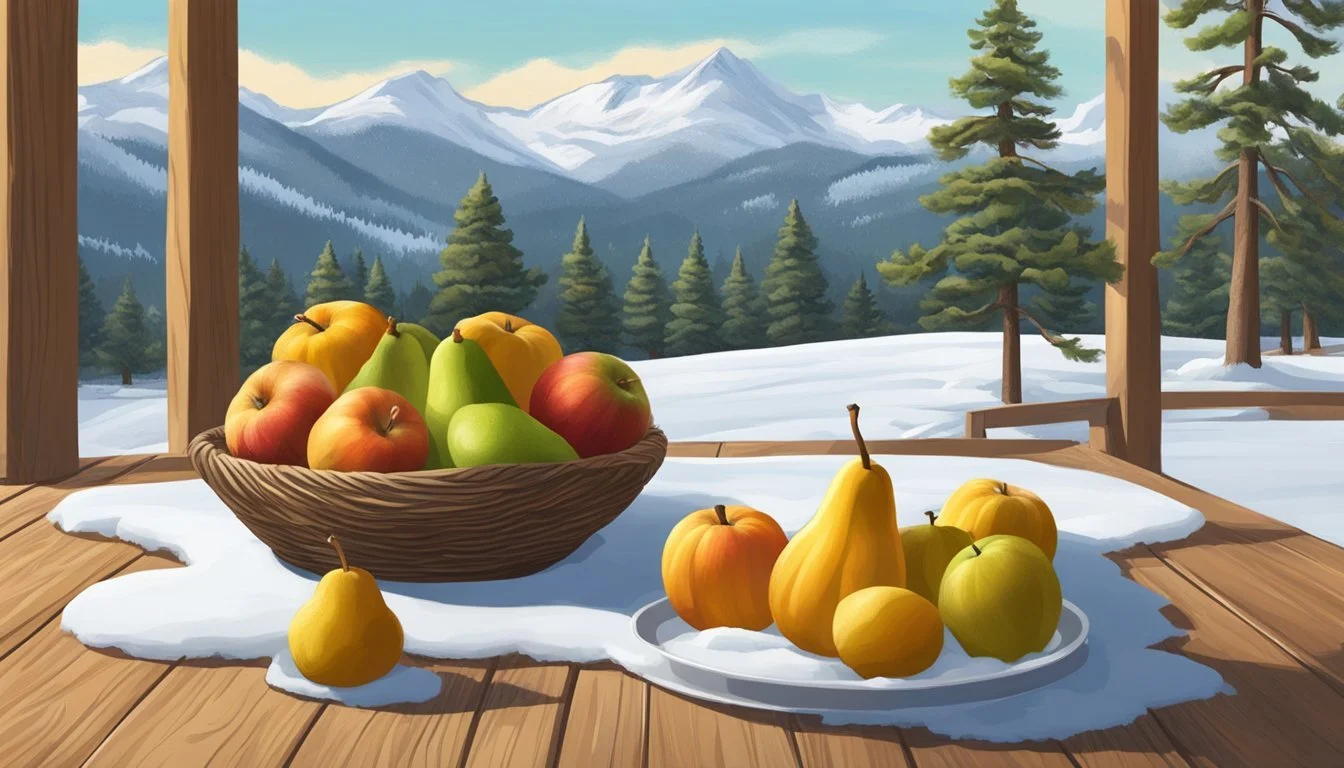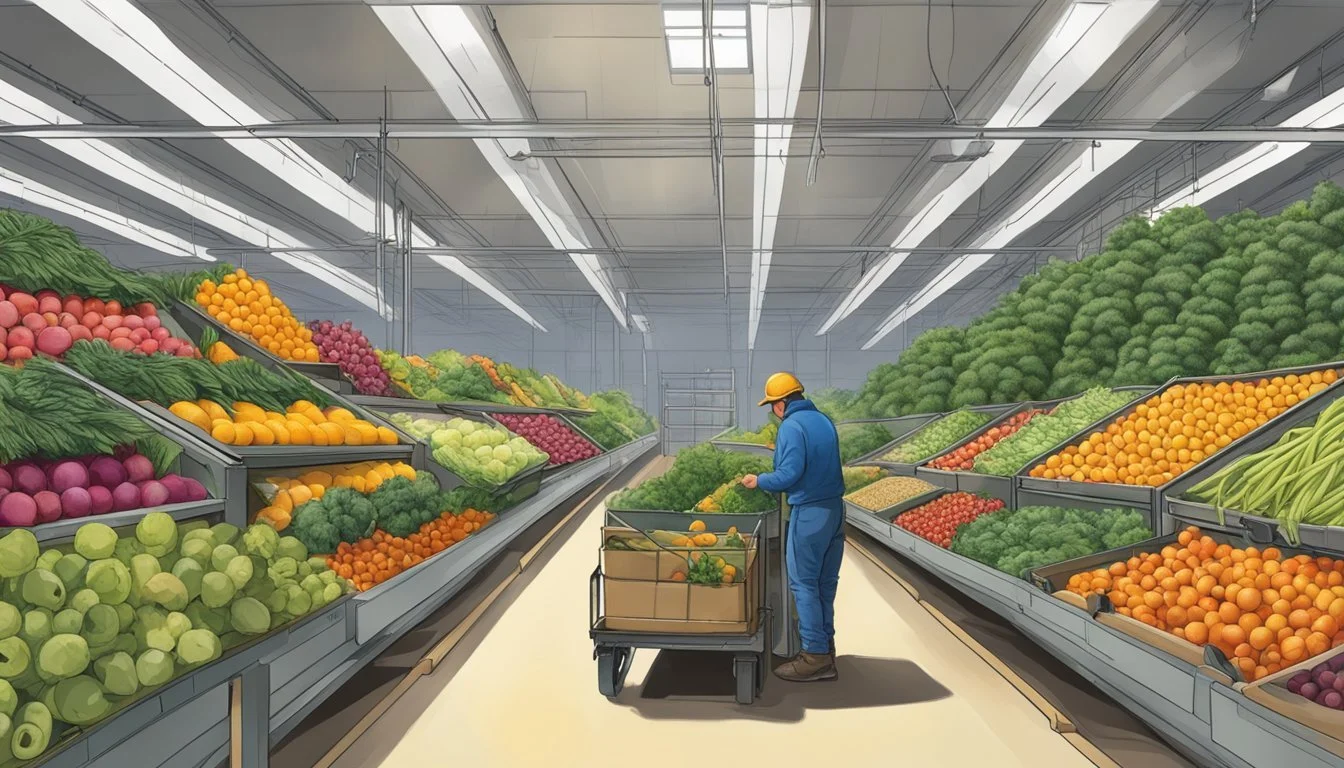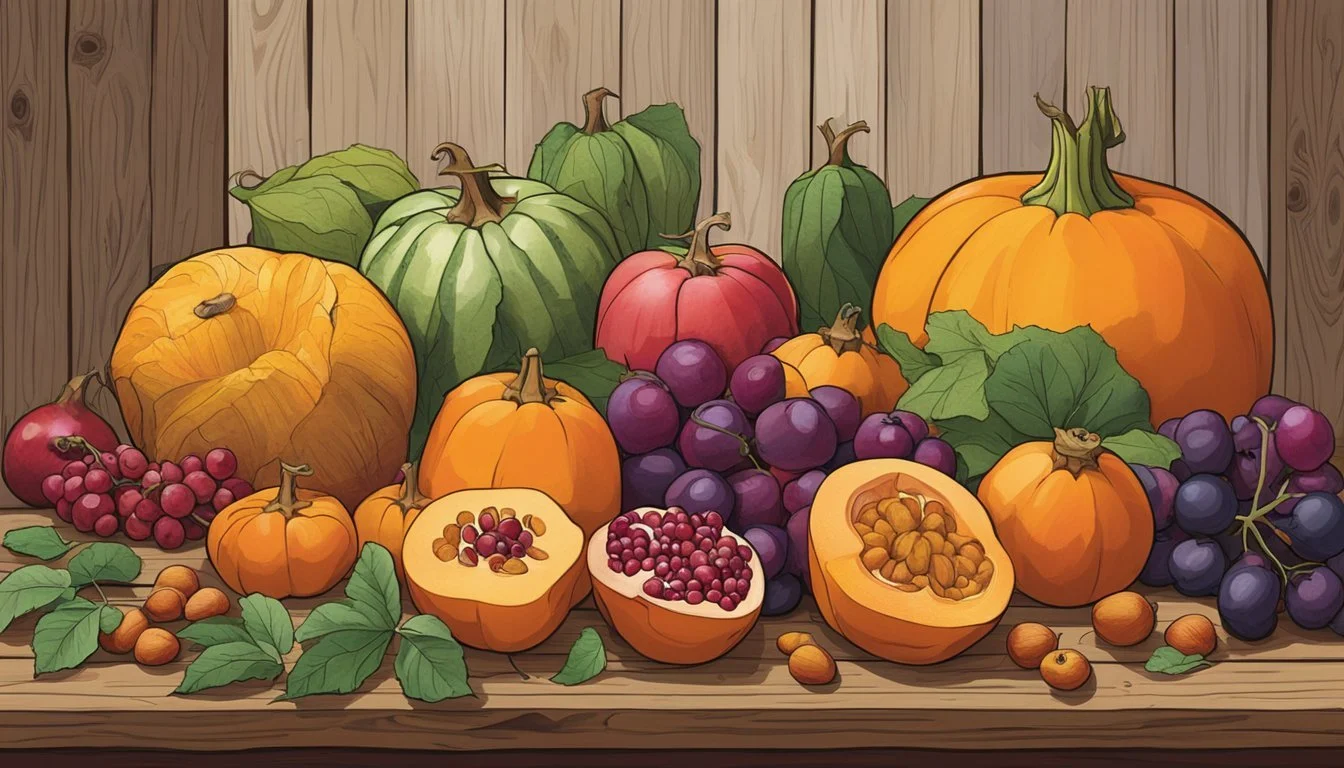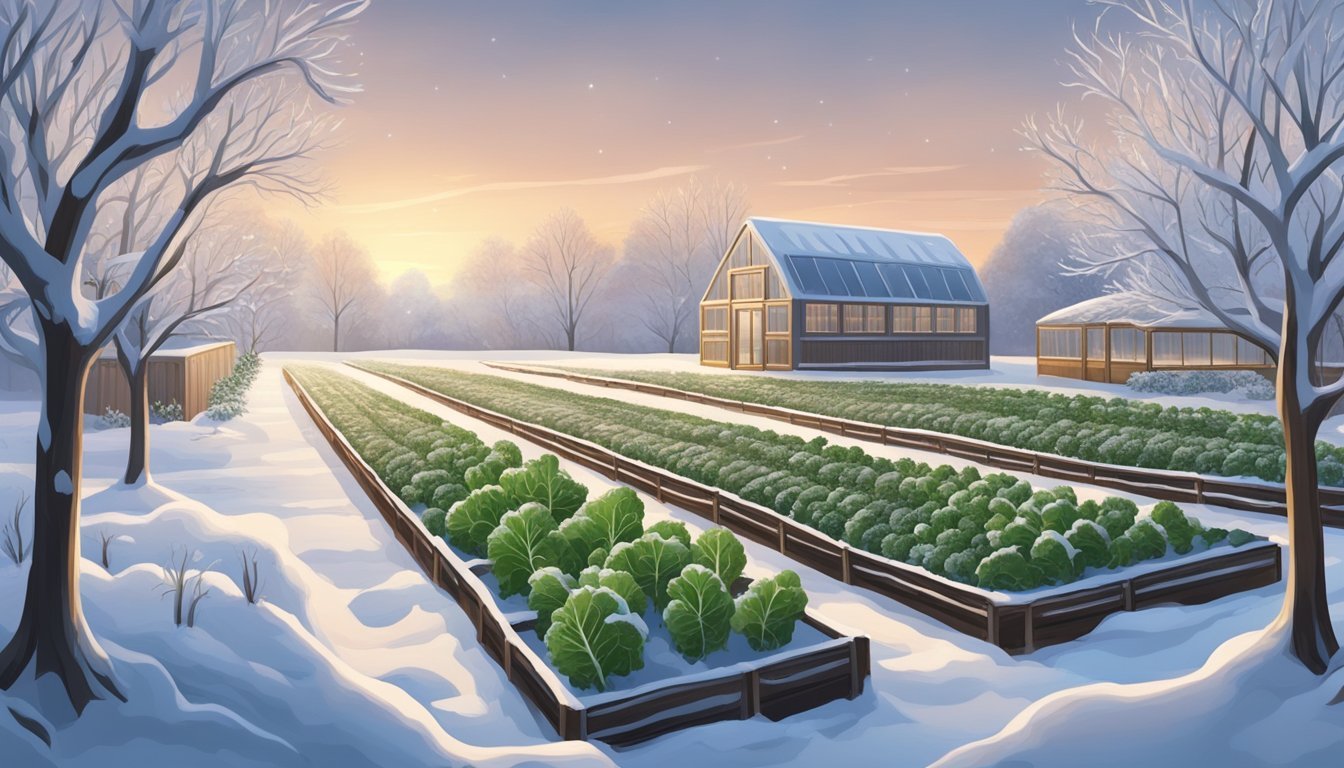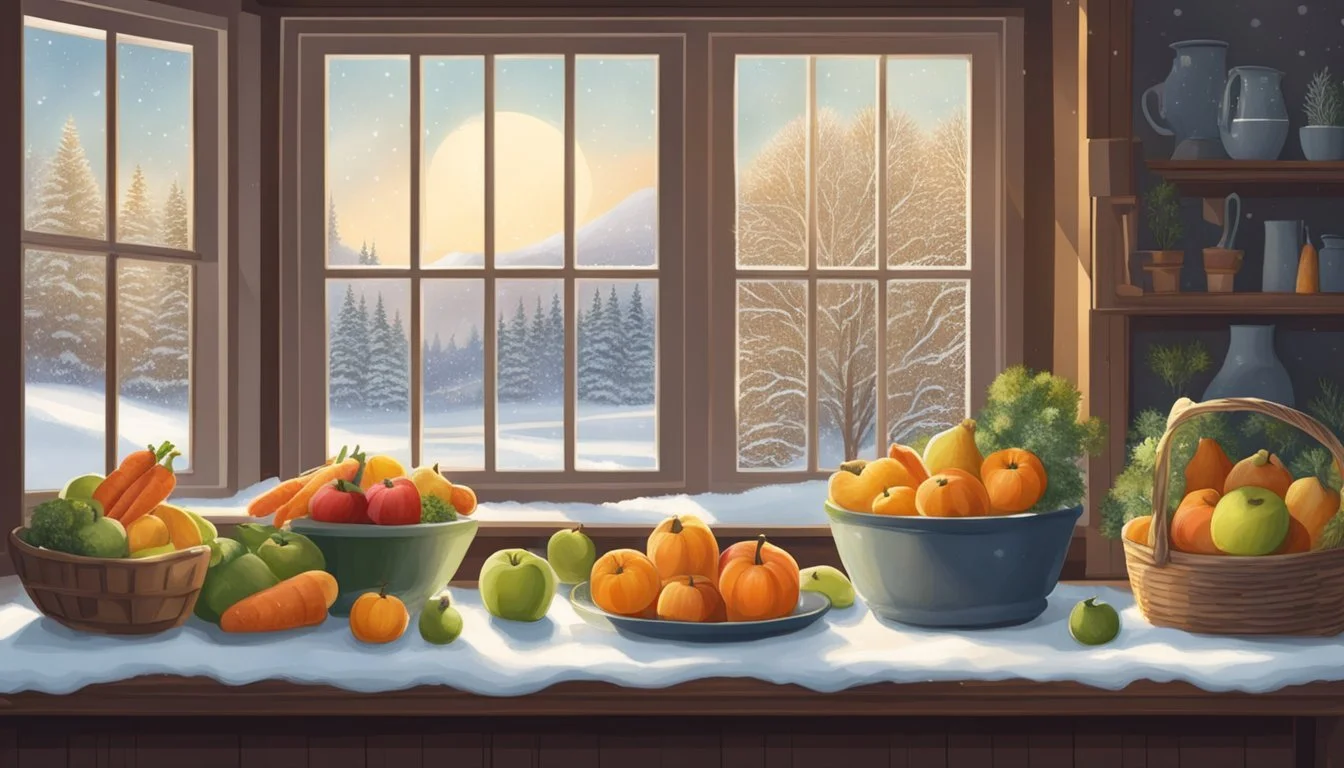Colorado Seasonal Fruit & Vegetables in December
Your Winter Produce Guide
This Article is Part of our Colorado Seasonal Fruit & Veg Calendar
In Colorado, December marks a time of transformation as the autumn harvest yields to the chill of winter. Despite the cold, an array of fruits and vegetables remain in season, offering a bounty of fresh options for holiday feasts and winter meals. Root vegetables and sturdy greens withstand the frosts, while some fruits are stored from earlier harvests to ensure availability.
Farmers and gardeners in the state have adapted to the cooler temperatures by focusing on crops that thrive in winter conditions. Produce such as winter squash and root vegetables like carrots (how long do carrots last?) and beets (how long do beets last?) are commonly available. Greenhouse cultivation also extends the growing season for certain crops, allowing for the production of fresh greens and herbs despite the snow-covered ground outside.
Consumers continue to enjoy local produce by visiting winter farmers markets or participating in community-supported agriculture programs that provide a selection of what’s fresh and in-season. The emphasis on locally grown produce ensures that even as the days shorten and temperatures drop, Colorado's tables are graced with a variety of nutritious and flavorful fruits and vegetables.
Overview of Colorado's December Climate and Its Impact on Agriculture
December in Colorado is characterized by its cold climate and the onset of the winter season. Typical weather patterns include significant snowfall across the state, especially at higher elevations, which can affect access to fields and transport of agricultural goods. The temperature often drops below freezing, making frost a common occurrence.
Temperatures:
Daytime highs can vary, with warmer areas seeing temperatures in the 40s (Fahrenheit).
Nighttime lows often drop below freezing across the state.
Snow and Frost:
Snow coverage can affect the harvesting of winter crops and impede the planting of new crops for the next growing season.
Frost may damage or kill sensitive plants, impacting yields.
Agriculture during December faces challenges primarily due to water availability. The reduction of winter chill hours due to rising temperatures may harm the dormancy cycle of certain fruits and hinder their development. Moreover, snowpack, critical for water resources in the subsequent months, can be less reliable due to climate variability.
Growing Season:
Shortened due to cold and snow, impacting the types of crops that can be successfully grown.
Frost-sensitive crops are typically not viable in this season without protective measures.
Farmers must adapt their practices to accommodate the state’s water resource issues, potential snowpack reductions, and erratic winter chill hours, all of which are critical for December agriculture in Colorado.
Seasonal Fruit Available in December
Colorado's markets in December showcase a selection of fruits that can be enjoyed both raw and cooked. While the range is more limited due to the cold weather, shoppers can still find nutritious options that are at their peak during this time.
Citrus Fruits
Oranges: Packed with vitamin C, oranges are a staple of winter produce.
Clementines: They are smaller and sweeter than oranges, perfect for snacking.
Stored Harvest Fruits
Apples: Various apple varieties remain crisp and flavorful, having been stored post-harvest.
Pears: They retain their quality through careful cold storage and ripen to perfection indoors.
Hoophouse-Grown Fruits
Strawberries: Though uncommon, some strawberry varieties can be grown in hoophouses, providing a sweet treat even in winter.
Shoppers seeking seasonal produce can look forward to these fruits in Colorado's markets during December, ensuring fresh, delicious options for holiday meals (What wine goes well with holiday meals?) and daily nutrition.
Seasonal Vegetables Available in December
In Colorado during December, markets are stocked with a robust variety of seasonal vegetables, providing a wealth of options for winter cooking. From hearty root vegetables that are ideal for soups and stews, to nutritious greens that enliven salads, residents have access to produce that can be roasted, mashed, or enjoyed fresh.
Root Vegetables
Root vegetables are at their peak in December and feature prominently in winter dishes. These vegetables store well and can be used in a variety of ways:
Potatoes: Staples for roasted or mashed preparations.
Carrots and Beets: Sweet and earthy, perfect for roasting or adding color to salads.
Turnips and Radishes: Offer a peppery punch, ideal for roasting or pickling.
Rutabagas and Parsnips: With a creamy texture when cooked, they're excellent in stews.
Celery Root: Also known as celeriac, it can be mashed or used to enhance the flavor of soups.
Cruciferous Vegetables
These vegetables are recognized for their health benefits and distinctive flavors.
Broccoli and Cauliflower: Versatile for both raw and cooked applications.
Cabbage: A staple in slaws and fermented to make sauerkraut.
Brussels Sprouts (how long do brussels sprouts last?): Delicious when roasted, bringing out a nutty sweetness.
Leafy Greens
Even in the colder months, leafy greens thrive in Colorado and are a source of vitamins and nutrients.
Kale (What wine goes well with kale?) and Spinach: Hardy greens that are great for salads and sautéing.
Chard: Its tender leaves work well sautéed or in soups.
Lettuce: Provides a fresh, crunchy base for winter salads.
Winter Squash Varieties
Squash is a hearty winter crop that provides comfort in every bite.
Squash: Includes varieties like acorn, butternut, and delicate.
Pumpkins: Not just for pies, they can be roasted or turned into soup.
Winter Squash: Rich in flavor, it can be baked, steamed, or pureed for various dishes.
Alliums
The allium family provides foundational flavors to countless dishes, with several types available during December.
Onions and Garlic: Essential for flavor in a wide range of recipes.
Leeks: Milder in taste, perfect for adding depth to soups and stews.
Harvesting and Storage Techniques
In Colorado, December's chill necessitates proper harvesting and storage techniques to ensure the longevity of produce, particularly for cold-tolerant and root vegetables common in this month. Harvesting should be timed before deep frosts set in to protect the integrity of the vegetables.
Cold-tolerant Crops: These include kale, Brussels sprouts, and leeks, which can survive light frosts that actually may sweeten their flavor. They should be harvested while firm and crisp, typically in the morning when temperatures are cool.
Root Vegetables: Carrots, turnips, and beets are examples of root crops that are often still available in December. They should be carefully dug out to avoid bruising. Once harvested, excess soil must be brushed off, and the greens should be trimmed to about an inch to prevent moisture loss.
Storage Conditions:
Temperature: Root vegetables thrive in cool, not freezing, environments. Ideally, storage temperatures should be kept between 32-40°F (0-4°C).
Humidity: High humidity levels of 90-95% are preferable for root vegetables to help maintain freshness.
Ventilation: Adequate air circulation is essential to prevent mold and spoilage.
Climate Considerations: Colorado's varied elevation and climate zones mean storage techniques may need adjustment. Higher altitudes require more insulation to protect produce from freezing, while lower areas may not be as cold.
In summary, storing produce at the correct temperature and humidity, combined with careful harvesting, can extend the enjoyment of Colorado’s December harvests well past their picking. Knowledge of one’s specific climate aids in tailoring storage solutions for maximum vegetable preservation.
Health Benefits of Eating Seasonally
Eating seasonally confers numerous health advantages. When individuals consume fruits and vegetables that align with the current season, they often ingest produce that is at its peak in terms of flavor and nutritional value. Seasonal produce tends to be more nutritious, as it is harvested at the perfect time for taste and freshness.
Nutrients: Seasonal selections like winter squash and root vegetables provide high levels of vitamins and minerals. They are also typically rich in fiber, which supports a healthy digestive system.
Flavor: Consuming fruits and vegetables during their natural harvest season can significantly enhance the taste of meals. Not only does this make eating a more enjoyable experience, but it may also encourage the consumption of more fruits and vegetables, which are integral components of a balanced diet.
Preparation: Seasonal produce can be enjoyed raw or cooked, satisfying a variety of preferences. Raw vegetables retain most of their natural nutrients and tend to be higher in fiber, which can be beneficial for one's health. Cooking can enhance certain nutrients and make others more bioavailable, as well as offering a diversity of textures and flavors to meals.
Seasonal Produce Suggested Preparation Winter Squash Roasted or pureed in soups Root Vegetables Raw in salads or steamed as a side dish
By focusing on seasonal eating, people can create meals that are not only nutritious but also align with environmental sustainability. It supports local agriculture and reduces the carbon footprint associated with transporting out-of-season produce from distant locations.
Local Markets and Buying Tips
When shopping for seasonal produce in Colorado, consumers are encouraged to visit local markets for the freshest options. Colorado Proud, a program supporting state agriculture, is a mark shoppers should look for, indicating locally grown produce.
Local markets often have a diverse selection of December produce, including cold-hardy vegetables and storage crops. Shoppers might find items like kale, carrots, and beets. They should ask the produce manager for the origins of fruits and vegetables to ensure they support local agriculture.
Here are some tips for buying at local Colorado markets in December:
Check for Origin: Look for stickers or signs indicating if the produce is from Colorado.
Ask Questions: Engage with market staff to learn about the seasonal produce available.
Colorado Proud: Seek out the Colorado Proud logo for assurance of local sourcing.
Most importantly, consumers should consider the resources used for out-of-season items and aim to buy what is seasonally appropriate. This supports state agriculture and reduces carbon footprint. Here's a streamlined list of what to expect at markets:
Seasonal Produce Availability Kale Available Carrots Available Beets Available Pears (storage or poached) Limited
In summary, when shoppers purchase seasonal produce, they are not only getting fresher, tastier foods but also contributing to the local economy and sustainable practices.
Creative Cooking Ideas for December Produce
In December, Colorado's bounty includes a range of hearty vegetables and vibrant citrus fruits. Chefs and home cooks alike can make the most of these seasonal offerings through a variety of cooking methods that highlight their natural flavors.
Roasted Vegetables: A simple yet deeply flavorful way to prepare winter vegetables is to roast them. Toss carrots, Brussels sprouts, and sweet potatoes with olive oil and a sprinkle of salt and pepper. Roasting at a high heat caramelizes their natural sugars, resulting in a sweet, nutty flavor perfect for a comforting side dish.
Hearty Stews: For those colder nights, one might consider combining kale or other greens into a rich, filling stew. These leafy vegetables add nutritional value and texture, enhancing the heartiness of the dish. Barley or beans can extend the stew, making it a satisfying meal.
Vibrant Salads: Citrus fruits such as clementines and pomegranates provide a bright, refreshing contrast to the robust flavors of winter greens. Segment oranges and toss with arugula (how long does arugula last?), adding a drizzle of balsamic glaze for a salad that is visually striking and bursts with seasonal taste.
Method Suggested Produce Preparation Tips Roasted Sweet potatoes, carrots Olive oil, salt, thyme Mashed Potatoes, parsnips Butter, warm milk Salads Arugula, citrus, pomegranate Balsamic vinegar dressing Stews Kale, beans Slow cook with broth Soups Broccoli, cauliflower Purée for smooth texture
For soups, recipes can utilize broccoli and cauliflower to create creamy purees or chunkier, rustic soups. A good blend of herbs and a splash of cream can turn these simple vegetables into a luxurious treat on a chilly day.
Cooking in December doesn't have to be limited by the colder weather. On the contrary, the seasonal produce available provides ample opportunity for creativity and flavor in the kitchen.
Tips for Growing Your Own Winter Produce
Growing winter produce in Colorado requires understanding the local climate and its implications on the growing season. In December, gardeners face low temperatures and frost, which can challenge but also offer opportunities for a productive winter garden.
Selection of Crops: Certain vegetables can tolerate cold Colorado winters, making them suitable candidates for the winter garden.
Leafy Greens: Hardy varieties such as kale and spinach can thrive in cold weather.
Root Vegetables: Carrots, beets, and radishes are well-suited for cooler temperatures and can be harvested into the winter months.
Microclimate Management: Creating a microclimate provides a more controlled environment, protecting plants from harsh conditions.
Utilize cold frames or hoop houses to insulate plants against the cold.
Apply mulches to keep the soil temperature stable and protect roots from freezing.
Planning and Timing: Understanding the first and last frost dates in one's specific location within the state is essential for a successful harvest.
Planting Schedule: Crops should be sown at the right time to mature before the harshest weather.
Soil Considerations: Colorado's soil often requires amendments to support agriculture during colder months.
Incorporating organic matter can improve soil structure and fertility.
In summary, by selecting the right crops, creating favorable microclimates, timing the planting season appropriately, and preparing the soil, Colorado residents can enjoy a bountiful harvest of winter produce despite the cold and frost that defines the state's winter agriculture landscape.
Conclusion
In December, Colorado's climate fosters a limited but distinctive range of produce. Markets across the state adapt to the colder season by featuring produce that thrives in these conditions. Consumers can find nutrient-rich vegetables and hardy fruits that are well-suited for the season.
Colorado's unique climate includes cold winters, necessitating a shift in available produce. However, selections such as winter squash remain available until February, offering both flavor and nutrition.
Produce commonly found in Colorado during December includes:
Root vegetables: such as beets and carrots, which store well and can be used in a variety of dishes.
Leafy greens: including kale and collard greens (how long do collard greens last?), known for their nutrient density.
Shopping for seasonal produce in Colorado ensures that consumers receive fresh, flavorful vegetables and fruits, while also supporting local agriculture. It also helps in environmental conservation by reducing the carbon footprint associated with long-distance transportation.
By focusing on seasonal produce in December, Coloradans benefit from a healthful diet even when the variety of available fruits and vegetables is narrower than in the bountiful summer months.

